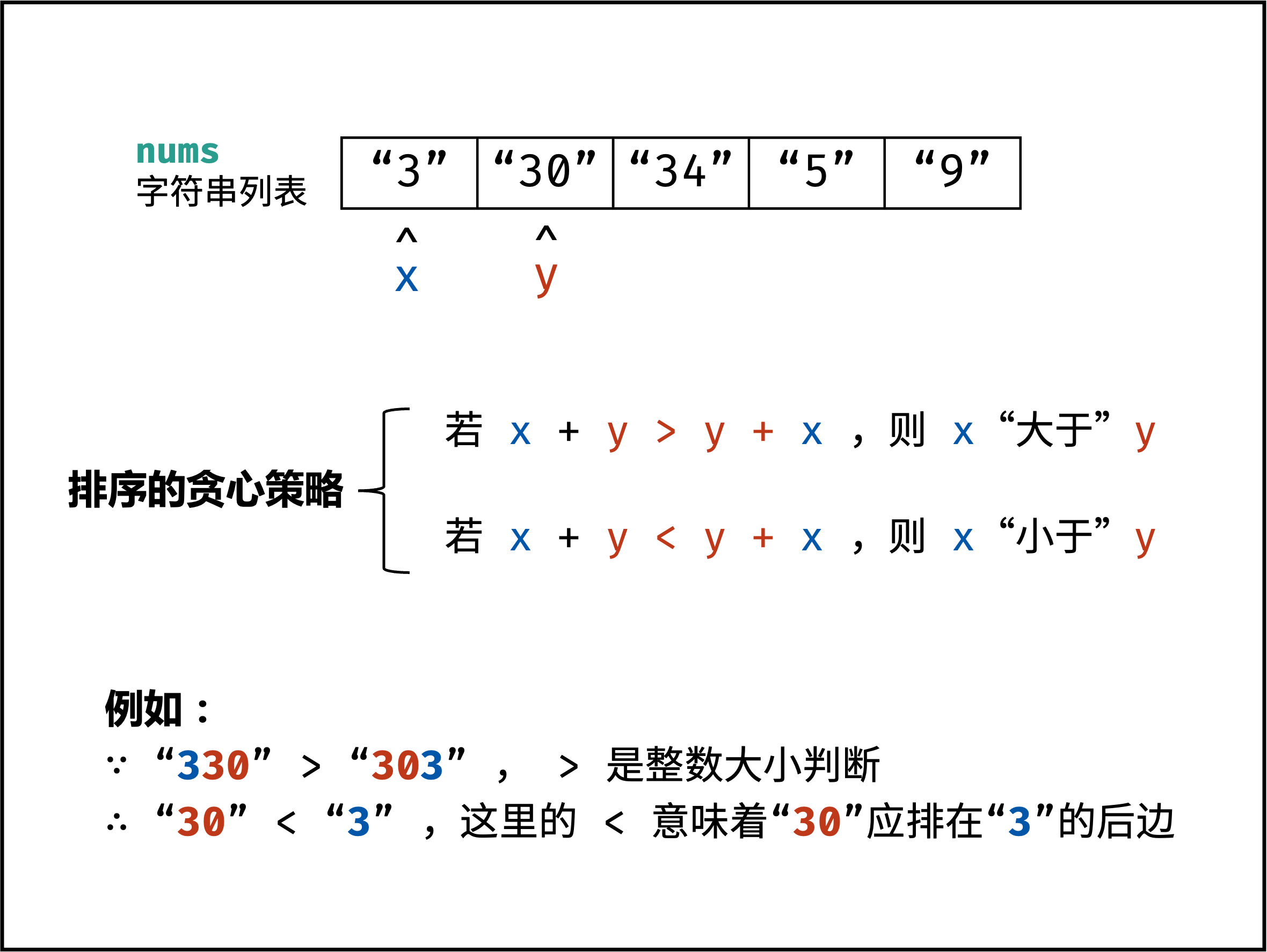解题思路:
此题求拼接起来的最大数字。设数组 $nums$ 中任意两数字的字符串为 $x$ 和 $y$ ,则规定 贪心策略:
- 若拼接字符串 $x + y > y + x$ ,则 $x$ “大于” $y$ 。
- 反之,若 $x + y < y + x$ ,则 $x$ “小于” $y$ 。
$x$ “小于” $y$ 代表:排序完成后,数组中 $x$ 应在 $y$ 左边;“大于” 则反之。
根据以上规则,套用任何排序方法对 $nums$ 执行排序即可。

算法流程:
- 初始化: 字符串列表 $strs$ ,保存各数字的字符串格式。
- 列表排序: 根据贪心策略对 $strs$ 进行从大到小排序。
- 返回值: 拼接 $strs$ 中的所有字符串,并返回。
正确性证明:
本题的贪心策略的正确性证明包括以下两个命题:
- 反身性:对于任意的数字 $x$,有 $xx = xx$。
- 传递性:假设对于任意的数字 $x$ , $y$ , $z$ ,如果 $xy < yx$ , $yz < zy$ ,那么 $xz < zx$ 一定成立。
反身性是显然成立的,因为任意数字和自己拼接总是相等。下面证明传递性:
设十进制数 $x$ , $y$ , $z$ 分别有 $a$ , $b$ , $c$ 位,则有(左边是字符串拼接,右边是十进制数计算,两者等价):
$$ xy = x \times 10^b + y \ yx = y \times 10^a + x $$
则 $xy < yx$ 可转化为:
$$ x \times 10^b + y < y \times 10^a + x \ x (10^b - 1) < y (10^a - 1) \ x / (10^a - 1) < y / (10^b - 1) $$
同理, 可将 $yz < zy$ 转化为:
$$ y / (10^b - 1) < z / (10^c - 1) $$
将以上两式合并,整理得:
$$ x / (10^a - 1) < y / (10^b - 1) < z / (10^c - 1) \ x / (10^a - 1) < z / (10^c - 1) \ x (10^c - 1) < z (10^a - 1) \ x \times 10^c + z < z \times 10^a + x $$
可推出 $xz$ < $zx$ ,传递性证毕。
因此贪心策略是正确的,所得排序结果是全局最优的。
代码(内置函数):
可使用编程语言的内置排序函数实现,需自定义判断规则。
class Solution:
def largestNumber(self, nums: List[int]) -> str:
def sort_rule(x, y):
a, b = x + y, y + x
if a < b: return 1
elif a > b: return -1
else: return 0
strs = [str(num) for num in nums]
strs.sort(key = cmp_to_key(sort_rule))
if strs[0] == "0":
return "0"
return ''.join(strs)class Solution {
public String largestNumber(int[] nums) {
String[] strs = new String[nums.length];
for (int i = 0; i < nums.length; i++)
strs[i] = String.valueOf(nums[i]);
Arrays.sort(strs, (x, y) -> (y + x).compareTo(x + y));
if (strs[0].equals("0"))
return "0";
StringBuilder res = new StringBuilder();
for (String s : strs)
res.append(s);
return res.toString();
}
}class Solution {
public:
string largestNumber(vector<int>& nums) {
vector<string> strs;
string res;
for (int i = 0; i < nums.size(); i++)
strs.push_back(to_string(nums[i]));
sort(strs.begin(), strs.end(), [](string& x, string& y){ return y + x < x + y; });
if (strs[0] == "0")
return "0";
for (int i = 0; i < strs.size(); i++)
res.append(strs[i]);
return res;
}
};代码(快速排序):
需修改快速排序函数中的排序判断规则。字符串大小(字典序)对比的实现方法:
- Python/C++ 中可直接用
<,>。 - Java 中使用函数
A.compareTo(B)。
class Solution:
def largestNumber(self, nums: List[int]) -> str:
def quick_sort(l , r):
if l >= r: return
i, j = l, r
while i < j:
while strs[j] + strs[l] >= strs[l] + strs[j] and i < j: j -= 1
while strs[i] + strs[l] <= strs[l] + strs[i] and i < j: i += 1
strs[i], strs[j] = strs[j], strs[i]
strs[i], strs[l] = strs[l], strs[i]
quick_sort(l, i - 1)
quick_sort(i + 1, r)
strs = [str(num) for num in nums]
quick_sort(0, len(strs) - 1)
if strs[-1] == "0":
return "0"
return ''.join(strs[::-1])class Solution {
void quickSort(String[] strs, int l, int r) {
if (l >= r) return;
int i = l, j = r;
String tmp = strs[i];
while (i < j) {
while ((strs[j] + strs[l]).compareTo(strs[l] + strs[j]) >= 0 && i < j) j--;
while ((strs[i] + strs[l]).compareTo(strs[l] + strs[i]) <= 0 && i < j) i++;
tmp = strs[i];
strs[i] = strs[j];
strs[j] = tmp;
}
strs[i] = strs[l];
strs[l] = tmp;
quickSort(strs, l, i - 1);
quickSort(strs, i + 1, r);
}
public String largestNumber(int[] nums) {
String[] strs = new String[nums.length];
for(int i = 0; i < nums.length; i++)
strs[i] = String.valueOf(nums[i]);
quickSort(strs, 0, strs.length - 1);
StringBuilder res = new StringBuilder();
if (strs[strs.length - 1].equals("0"))
return "0";
for(int i = strs.length - 1; i >=0; i--)
res.append(strs[i]);
return res.toString();
}
}class Solution {
public:
string largestNumber(vector<int>& nums) {
vector<string> strs;
for (int i = 0; i < nums.size(); i++)
strs.push_back(to_string(nums[i]));
quickSort(strs, 0, strs.size() - 1);
if (strs[strs.size() - 1] == "0")
return "0";
string res;
for (int i = nums.size() - 1; i >=0; i--)
res.append(strs[i]);
return res;
}
private:
void quickSort(vector<string>& strs, int l, int r) {
if (l >= r) return;
int i = l, j = r;
while (i < j) {
while (strs[j] + strs[l] >= strs[l] + strs[j] && i < j) j--;
while (strs[i] + strs[l] <= strs[l] + strs[i] && i < j) i++;
swap(strs[i], strs[j]);
}
swap(strs[i], strs[l]);
quickSort(strs, l, i - 1);
quickSort(strs, i + 1, r);
}
};复杂度分析:
- 时间复杂度 $O(N \log N)$ : $N$ 为最终返回值的字符数量( $strs$ 列表的长度 $\leq N$ );使用快排或内置函数的平均时间复杂度为 $O(N \log N)$ ,最差为 $O(N^2)$ 。
- 空间复杂度 $O(N)$ : 字符串列表 $strs$ 占用线性大小的额外空间。